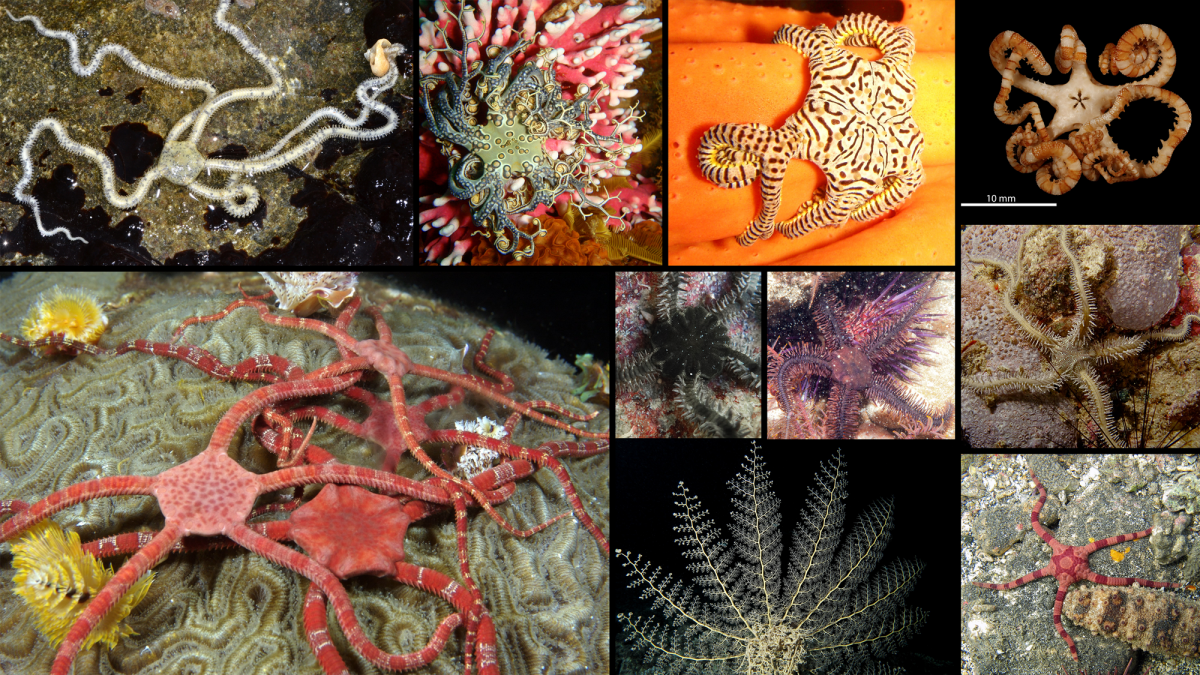Chapter contents:
Echinodermata
–– 1. Exclusively Fossil Taxa
–– 2. Crinoidea
–– 3. Asteroidea
–– 4. Ophiuroidea ←
–– 5. Echinoidea
–– 6. Holothuroidea
You can find 3D models of Ophiuroidea here!
This page is by Jaleigh Q. Pier and Jansen Smith. It was last updated June 27, 2022.
Above: Top Left: Amphiodia occidentalis by: Don Loarie (Wikimedia Commons; Creative Commons Attribution-ShareAlike 4.0 International License). Top Center Left: A basket star by: Peter Southwood (Wikimedia Commons, Creative Commons Attribution-ShareAlike 3.0 Unported License). Top Center Right: A basket star (Conocladus australis) by: Peter Southwood (Wikimedia Commons, Creative Commons Attribution-ShareAlike 3.0 Unported License). Top Right: A brittle star (Astroceras aurantiacum) by: Marie Hennion (Wikimedia Commons; Creative Commons Attribution-ShareAlike 4.0 International License). Bottom Left: Ruby brittle stars (Ophioderma rubicundum) by: NOAA (Public Domain). Center: Brittle star (Ophiocoma scolopendrina) by: Philippe Bourjon (Wikimedia Commons; Creative Commons Attribution-ShareAlike 4.0 International License). Center Right: Brittle star (Clarkcoma canaliculata) by: Julian Finn (Wikimedia Commons; Creative Commons Attribution-ShareAlike 4.0 International License). Right: Brittle star (Ophiomastix pictum) by: Bernard Dupont (Wikimedia Commons, Creative Commons Attribution-ShareAlike 2.0 Generic License). Bottom Center: The basket star (Astroboa nuda) by: Alexander Vasenin (Wikimedia Commons, Creative Commons Attribution-ShareAlike 3.0 Unported License). Bottom Right: Brittle star (Ophiolepis superba) by: Christophe Cadet (Wikimedia Commons; Creative Commons Attribution-ShareAlike 4.0 International License).
Class Ophiuroidea Snapshot
- Examples: brittle stars and basket stars
- Ecology: marine
- Key features of group: Mobile epifaunal filter feeder, detritivore, carnivore, omnivore
- Diversity: ~2,081 living sp., ~1,043 extinct sp.
- Fossil record: Ordovician to Recent
Overview
Ophiuroidea are commonly known as brittle stars based on the fragile nature of their snake-like arms. These serpentine arms in turn give them their scientific name: in Greek, "ophis" means snake and "oura" means tail. The morphology of this class follows the radial, mobile form of Deline et al. (2020). Brittle stars are similar in general appearance to sea stars (Asteroidea) and both belong to the Asterozoa clade. There are, however, distinct differences.
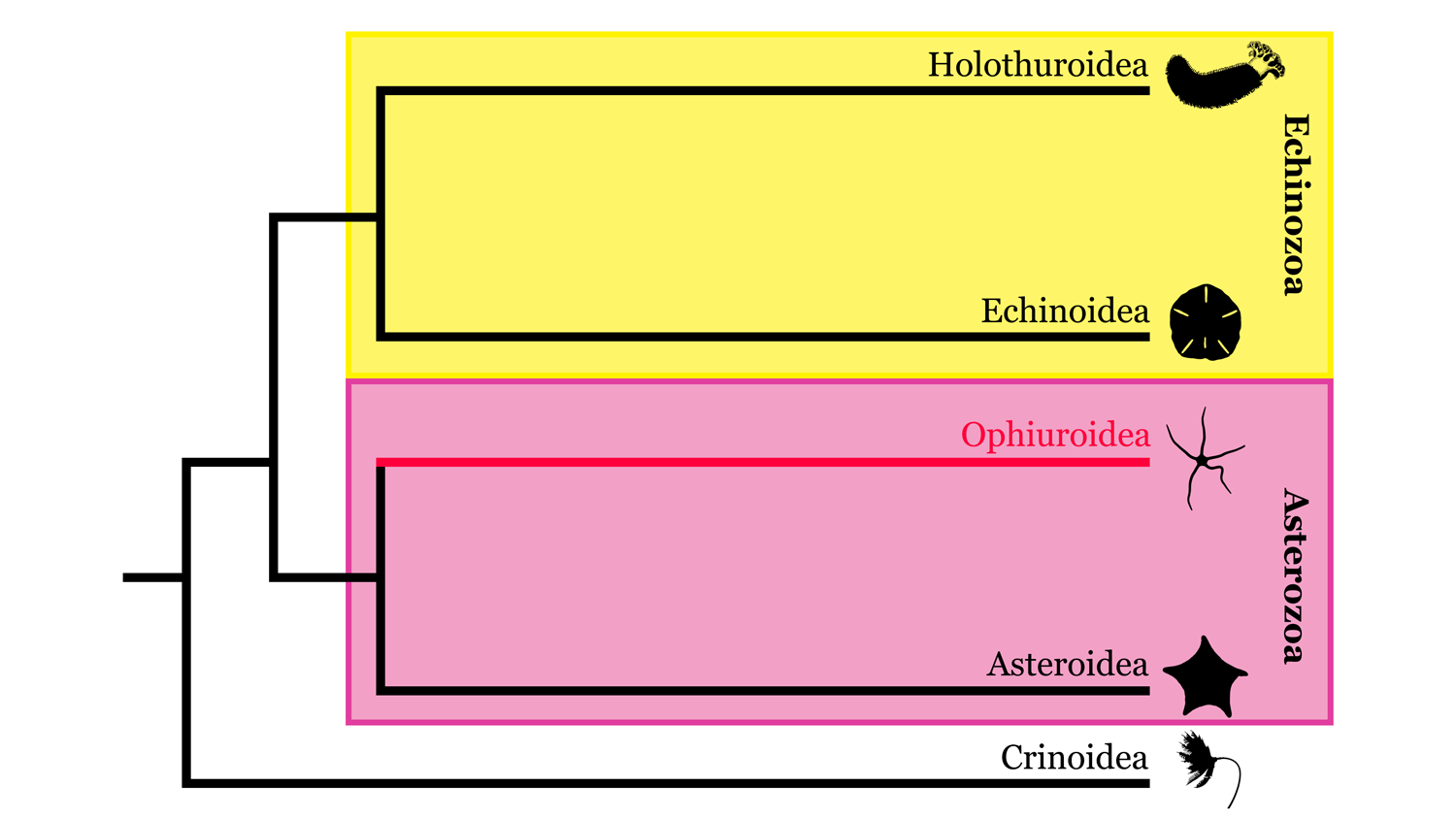
Highly simplified overview of Echinodermata phylogeny based in part on the hypothesis of relationships presented by Reich et al. (2015). Image by: Jaleigh Q. Pier, licensed under a Creative Commons Attribution-Share Alike 4.0 International License.
Ophiuroidea are the most speciose living echinoderm class, inhabiting all regions of the world’s oceans, and are often found in dense aggregations at great depths (>5,000m). Sometimes there are so many that they look like a carpet or meadow covering the entire ocean bottom. Unusual for an echinoderm, ophiuroids can also tolerate brackish water environments, a mix of freshwater and marine conditions.
A carpet of brittle stars. Video by: Peter van Rodijnen (Wikimedia Commons; Creative Commons Attribution-ShareAlike 3.0 Netherlands).
Below is an introduction to brittle stars featuring those commonly found living along the California coast.
'Facts: The brittle star' by: ‘Deep Marine Scenes’ (YouTube)
A well-defined central disk houses all of a brittle star's internal organs and is necessary to remain intact for regeneration to take place. When attacked, a brittle star can sever its own tissues anywhere along its own arm, which can regenerate just like sea stars. This self-amputation is called autotomy. A few brittle star species can asexually reproduce via fission (separation in half) of their central disk, with subsequent regeneration into two complete organisms.
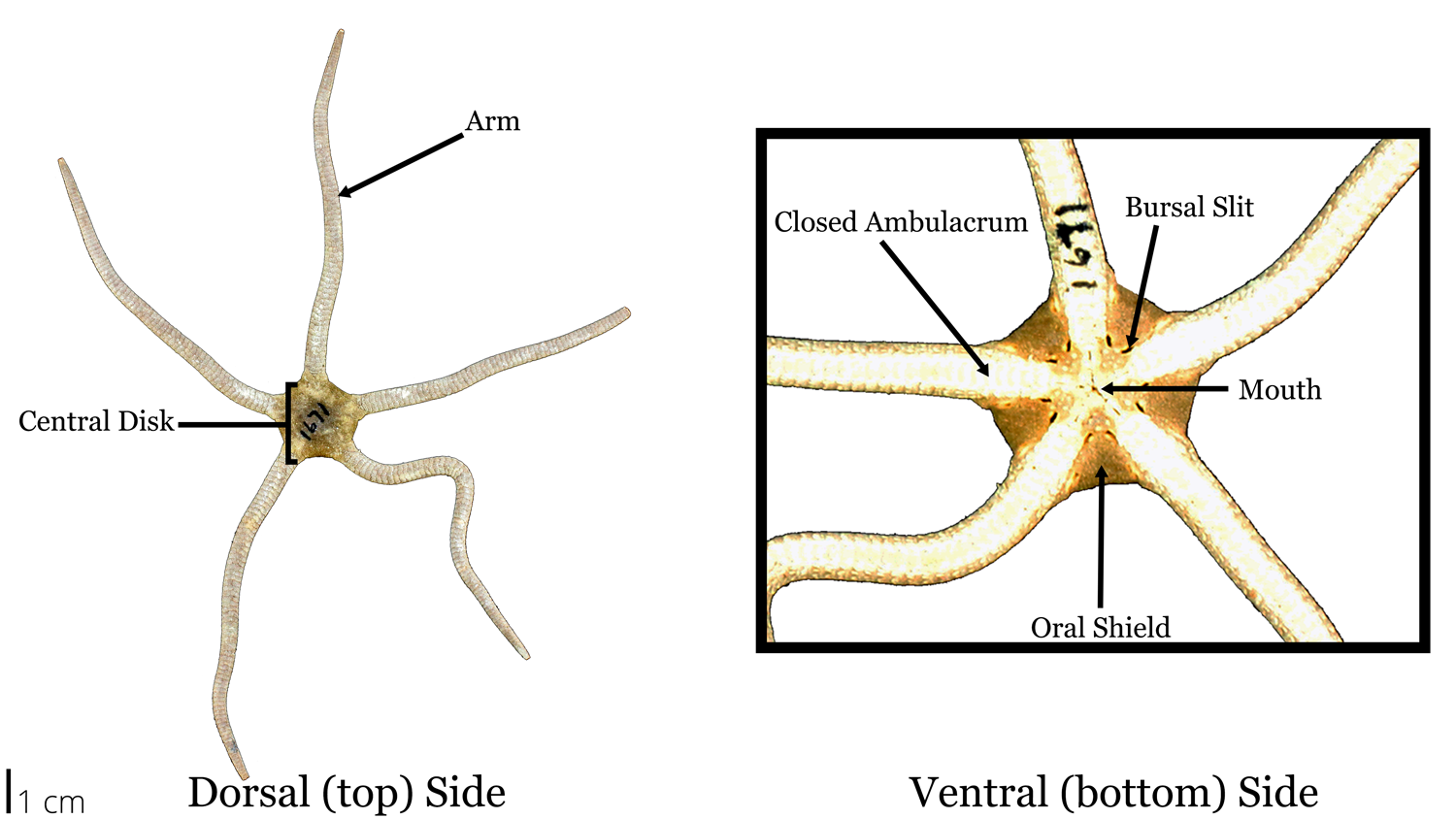
Image of a recent brittle star with labelled morphology; Left: dorsal (top) side Right: ventral (bottom) side. Image by: Jaleigh Q. Pier, licensed under a Creative Commons Attribution-Share Alike 4.0 International License.
Brittle stars tend to rely less on their water vascular system than other echinoderms such as sea stars or echinoids. Whereas sea stars rely on a multitude of tube feet to move across the ocean bottom, brittle stars use their whip-like arms to make their way from place to place, commonly using them to cling to sponges, corals, or even other animals. Although they typically have five arms, species with up to ten are known. Brittle stars also have a specialized endoskeleton with vertebral ossicles, which resemble true vertebrae with ball socket joints, to support their arms during speedy movement. Simple muscles allow the arms to move. Tube feet are still present, although greatly reduced compared to their sister clade the sea stars. Brittle stars push their bodies across the ocean floor with their arms and on rare occasion use them to swim. Watch the video below to see a swimming brittle star.
'Rare video of Brittle Star swimming in deep ocean' by: NOAA (YouTube).
Both the radial canal and the nerve cord are entirely housed within the closed ambulacrum. Calcium carbonate plates cover their arms, which are typically lined with spines. At the base of each arm, there are two bursal slits, which are used for respiration and release of gametes for reproduction. Brooding young is common for this group, which occurs within the bursal slits, and in some species dwarf males permanently attach themselves to the underside of the female’s central disk (Boardman, 1987, p. 590).
Opportunistic eaters
Ophiuroids are opportunistic eaters with a one-way digestive system. Many, like the basket stars (another kind of ophiuroid; see more about this group below), take advantage of floating particles and plankton, which they capture with their large branched arms. Others sense out decaying organisms. However, with a mouth that contains five jaw-like plates, they can be efficient predators of crustaceans and other small invertebrates. Watch the videos below!
'Brittle stars capture squid' by: SciNews (YouTube).
'Brittle Star Food Fight' by: Neptune Canada (YouTube).
Basket stars (Euryalida)
The largest of the Ophiuroidea are the basket stars, which usually have five arms that can be more than a meter wide. Each arm is divided into a series of branches, and the tiniest of these are covered in velcro-like spines and a mucous layer to capture particles and plankton. Basket stars typically anchor themselves with four arms while extending their fifth into strong currents to capture food. In deep waters, basket stars can be very numerous. This group of ophiuroids is one of the most recent to originate and has a fossil record that begins in the Mesozoic.
Basket stars from the Andaman Islands by: ‘Bubble Vision’ (YouTube).
Symbiosis with deep-sea corals
After the Deepwater Horizon oil spill of 2010 in the Gulf of Mexico, researchers began taking a closer look at the organisms living there. Months following the spill, oil found its way to the very bottom of the Gulf and began coating the thousands-of-years-old coral colonies with a black smothering layer of "floc" that resulted from oil spill contaminants. The corals were clearly suffering, coating themselves in mucus, losing polyps, and becoming covered in hydrozoans, which are a natural competitor for space on these deep-sea corals.
Researchers began analyzing hundreds of photographs of these deep-sea corals to monitor the consequences of the oil spill over time and started noticing a strange pattern. Corals with a healthy patch of branches that were free of floc always had a brittle star (Asteroschema clavigerum) entwined around the branches. It is believed this relationship is a true symbiosis, where the brittle star gets a home and the coral gets cleaned of floc and cleared of hydra polyps as the brittle star coils its arms in search of food. Even though the oil spill has caused both corals and brittle stars to decline in the region, this symbiosis provides a glimmer of hope for recovery.
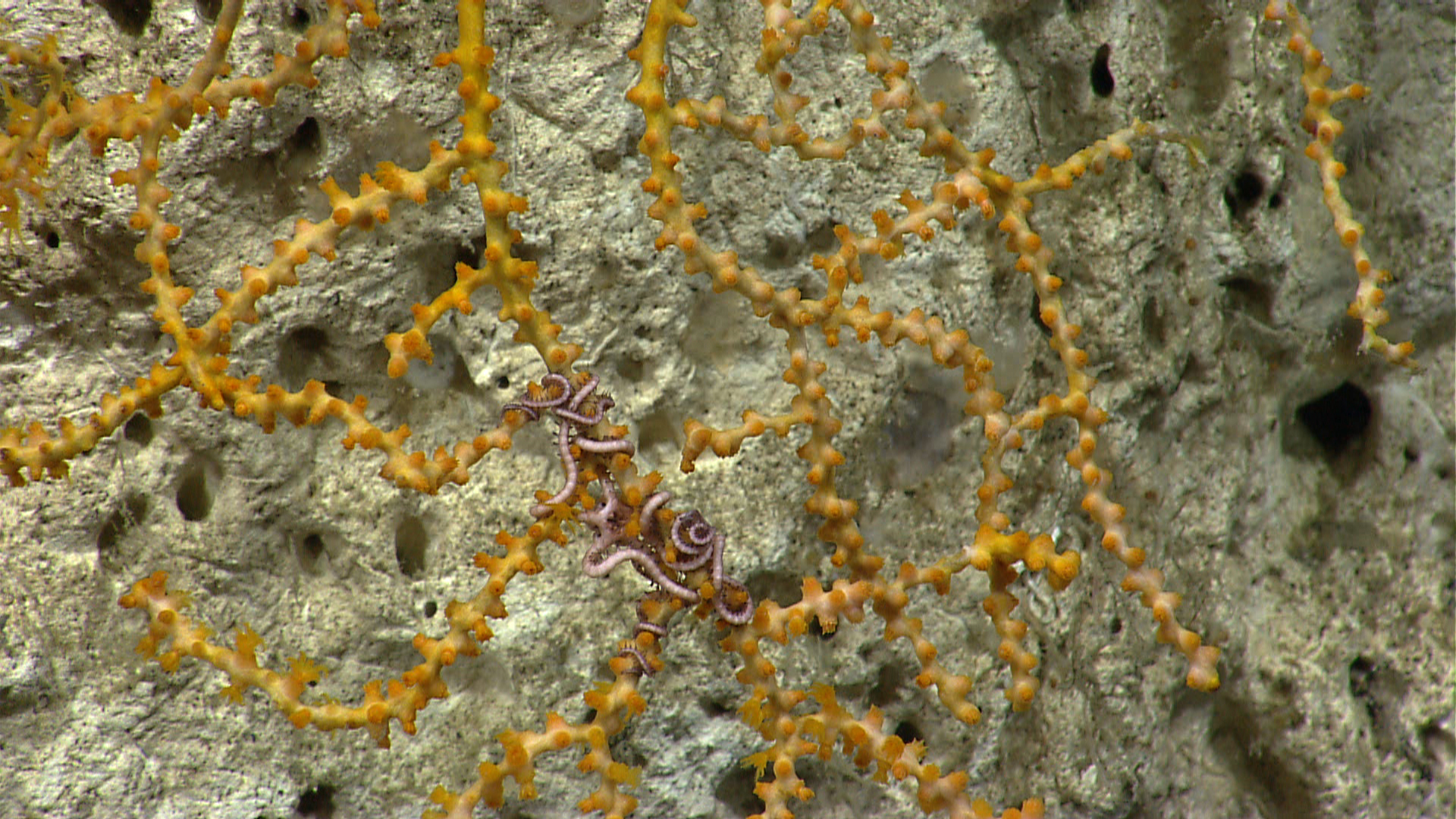
Healthy coral with brittle star coiled around its branches. Image by: NOAA (Public Domain).
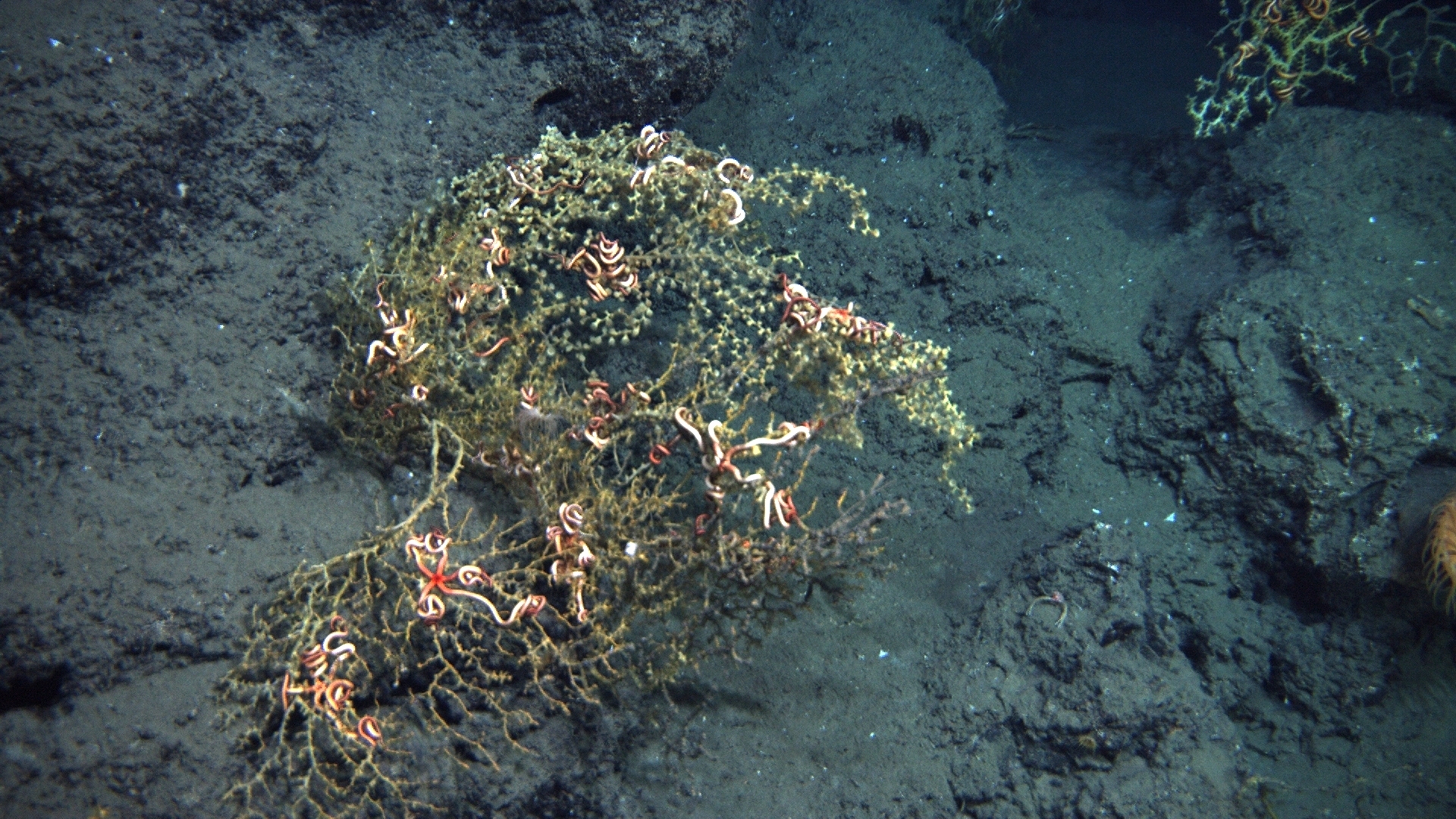
Area of the Gulf of Mexico affected by floc from the Deepwater Horizon oil spill. Image by: NOAA (Public Domain).
Bioluminescence
Bioluminescence is a common characteristic of ophiuroids. Research has shown this to be useful in anti-predatory tactics. Specialized cells called photocytes help emit these bioluminescent displays. Other echinoderm classes, including Holothuroidea, Crinoidea, and Asteroidea, also have bioluminescent species.
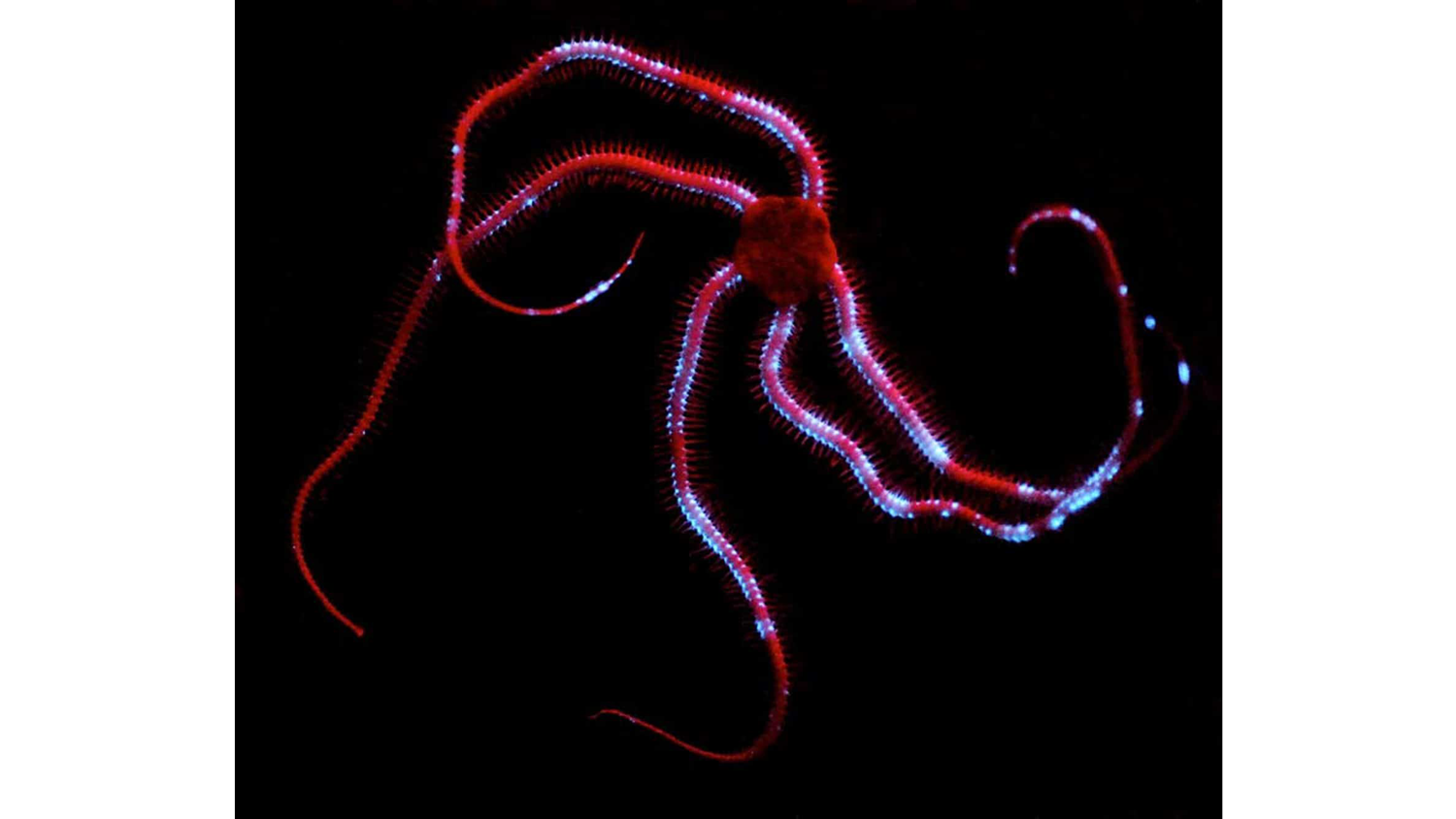
A brittle star emitting a blue bioluminescent display. Image by: Sönke Johnsen (NOAA;Public Domain).
Fossil Record
The ophiuroid fossil record, like that of the asteroids, is characterized by its incompleteness, particularly during the Paleozoic. This incompleteness is driven largely by the fragile nature of these “brittle stars” and by their occurrence in hard-substrate environments with poor preservational potential. Nonetheless, ophiuroids first appear in the fossil record during the Ordovician, much like the other four living classes of echinoderms. As discussed on the Asteroidea page, it has been hypothesized that ophiuroids and asteroids evolved from the Somasteroidea, an extinct asterozoan. Confirmation of this hypothesis is, however, hindered by the incompleteness of the echinoderm fossil record from the Ordovician and Cambrian.
Fossil specimen of brittle stars Ophiopinna elegans from the Jurassic of Ardeche, France (PRI 76732). Specimen is from the collections of the Paleontological Research Institution, Ithaca, New York. Longest dimension of rock is approximately 19.5 cm.
As discussed by Chen and McNamara (2006), four orders of ophiuroids have been identified from the Paleozoic, including Stenurida, Oegophiurida, Phrynophiurida, and Ophiurida. The Stenurida are known exclusively from the Ordovician to Devonian, but each of the other orders is represented in the Cenozoic. Even so, there has been considerable turnover of the families in these orders across this span of time, represented in the fossil record by increasing complexity of the calcareous plates through time. The Ophiurida are an exception to the family-level trend, to some degree, as several Ophiurida families did span the Permo-Triassic boundary and are the only families known to have done so.
Large accumulation of the fossilized legs of the brittle star (ophiuroid) Amphiura sanctaecrucis from the Miocene Santa Margarita Formation of San Luis Obispo County, California (PRI 81281). Specimen is from the research collections of the Paleontological Research Institution, Ithaca, New York (PRI 81281). Longest dimension of rock is approximately 23.5 cm.
The end-Permian extinction marks a substantial reorganization of ocean bottom communities and, during this reorganization, the ophiuroids appear to have thrived. Much like other groups of echinoderms, especially the crinoids, the ophiuroids diversified rapidly after the mass extinction. As discussed by Chen and McNamara (2006), this diversification included morphological innovations (e.g., advanced canal systems), expansion of ophiuroid ecological niche breadth, and efficient dispersal across the shallow oceans during the early Mesozoic. In addition, high predation and competition during this time (i.e., the Mesozoic Marine Revolution) likely drove some of these innovations. Indeed, Early Triassic ophiuroids became nimbler and more mobile that their Paleozoic ancestors, likely as a means to avoid predators (watch the video below to learn more). By the end of the Triassic, ophiuroids exhibited much of the ecological breadth and biogeographical distribution that they have today.
'The evolution of brittle stars' by: The Conversation (YouTube).
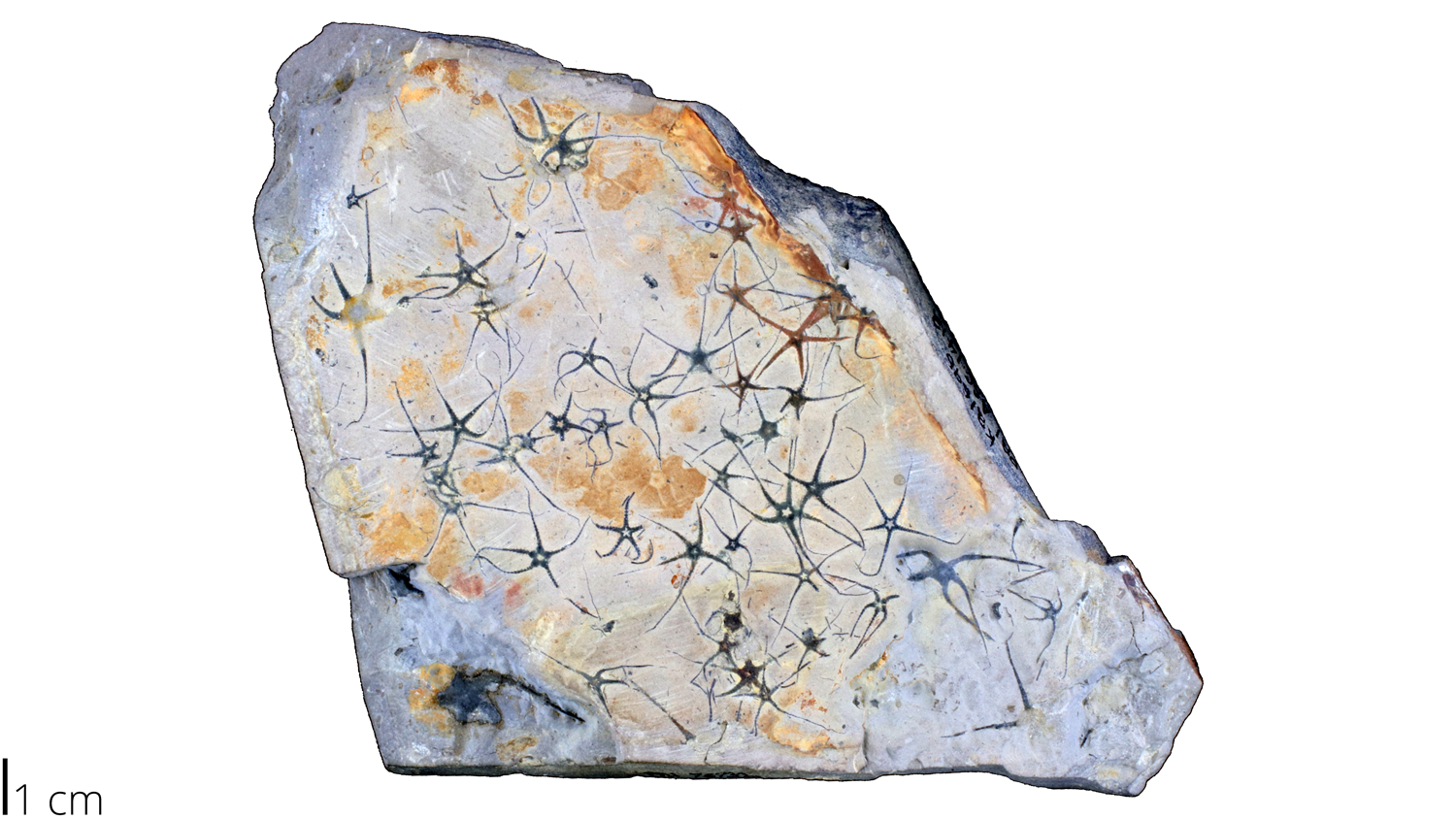
Fossil specimen of brittle stars Ophiopinna elegans from the Jurassic of Ardeche, France (PRI 76732). Specimen is from the collections of the Paleontological Research Institution, Ithaca, New York. Image by: Jaleigh Q. Pier, licensed under a Creative Commons Attribution-Share Alike 4.0 International License.
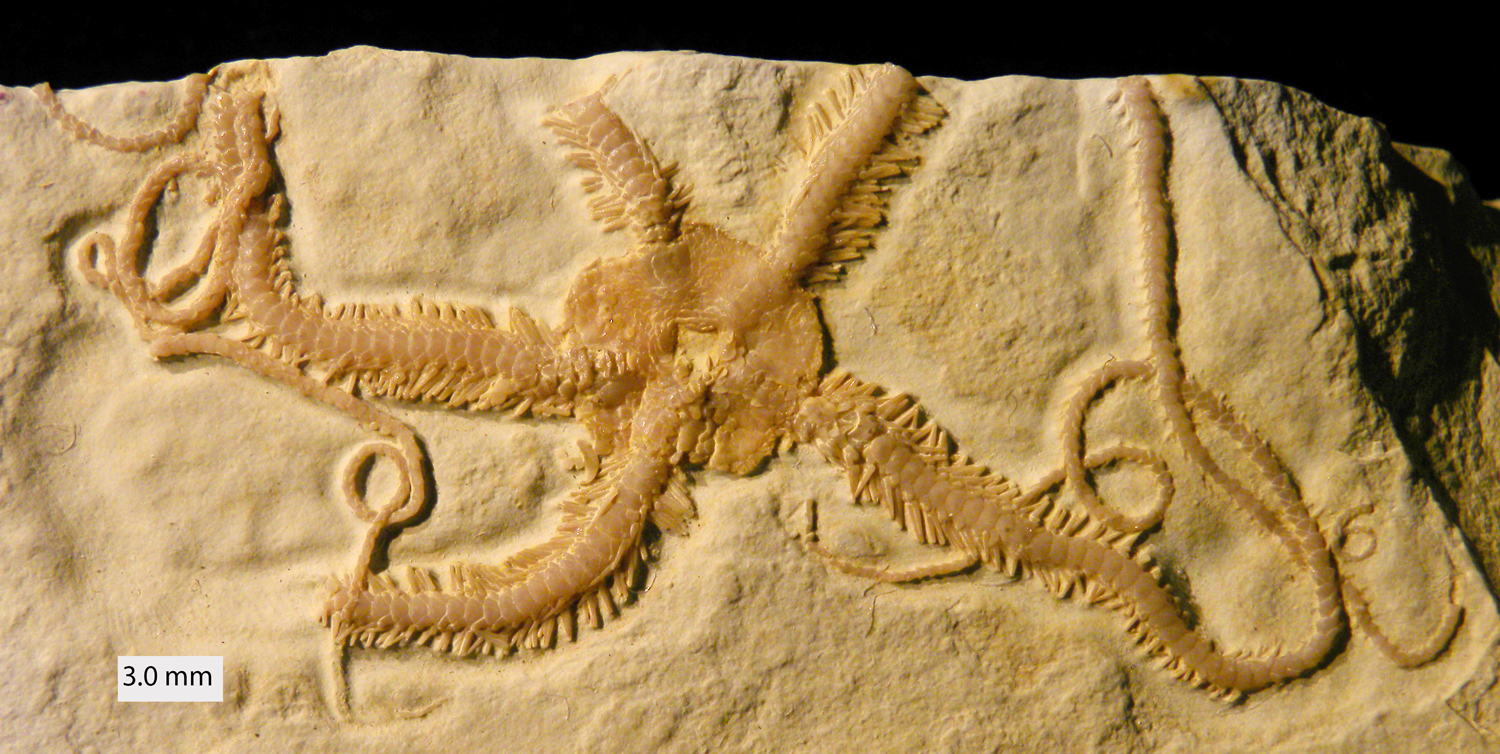
Ophiopetra lithographica from the Upper Jurassic of Germany. Image by: Mark A. Wilson (Wikimedia Commons; Creative Commons Universal Public Domain Dedication).
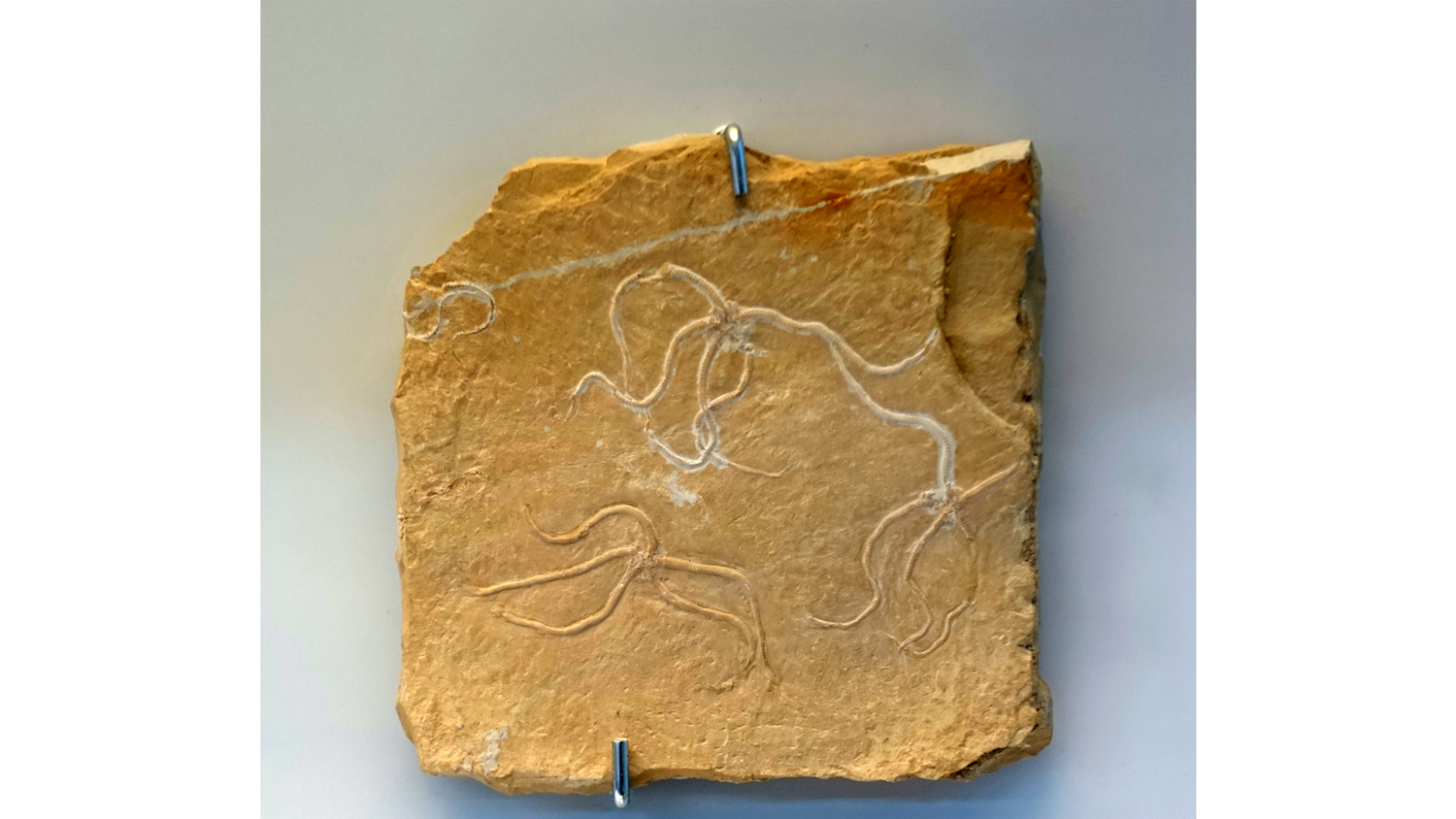
Sinosura kehlheimense brittle stars on display at the Naturhistorisches Museum Nürnberg in Nuremberg, Germany. Image by: 'Daderot' (Wikimedia Commons; Creative Commons Universal Public Domain Dedication).
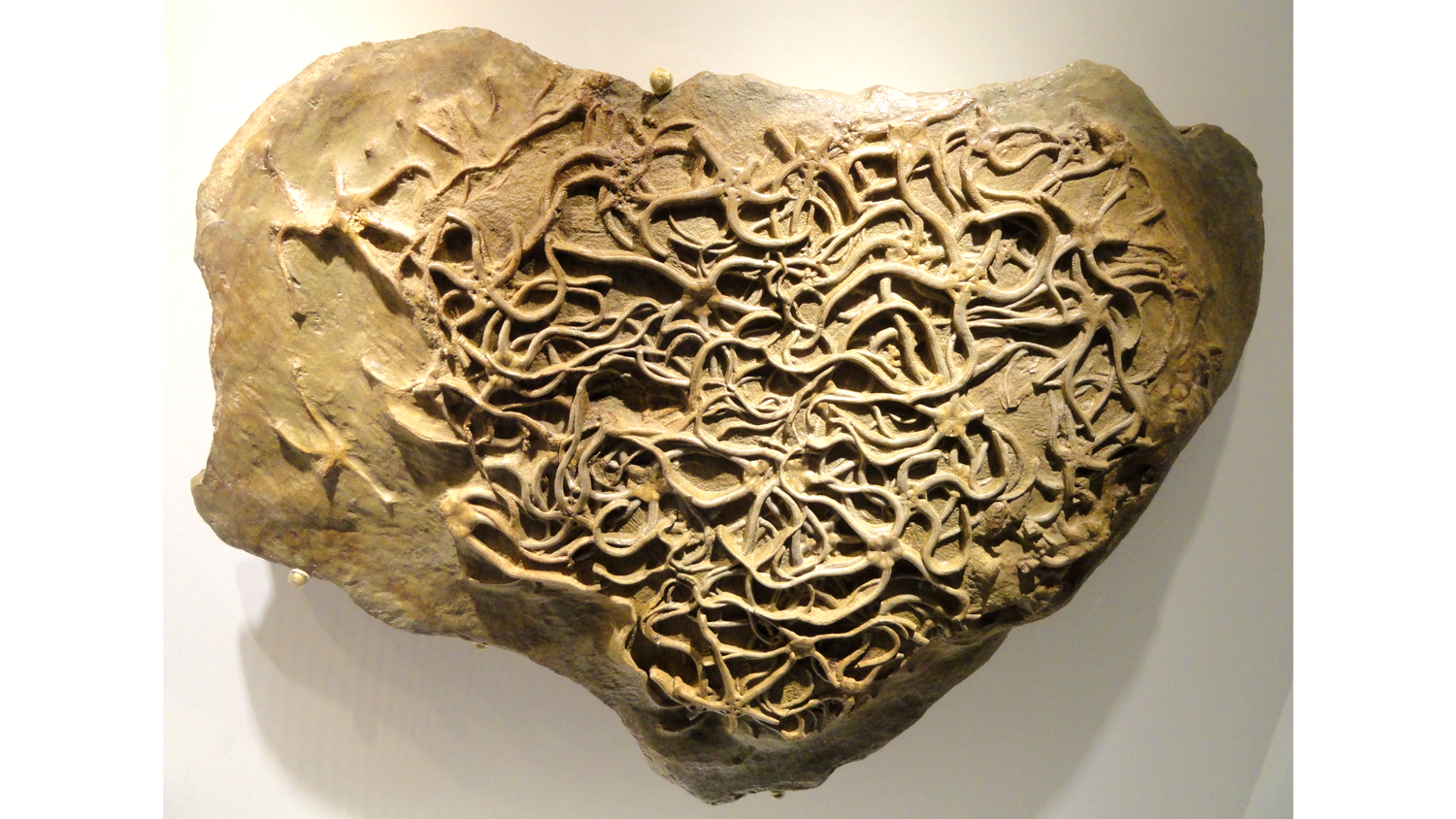
Paleocoma egertoni brittle stars from the Jurassic of England, currently on display at the Houston Museum of Natural Science. Image by: 'Daderot' (Wikimedia Commons; Creative Commons Universal Public Domain Dedication).
References and further reading:
Boardman, R.S., Cheetham, A.H., and Rowell, A.J. 1987. Fossil Invertebrates. Blackwell Scientific Publications. 713 pp.
Chen, Z. Q., and K. J. McNamara. 2006. End-Permian extinction and subsequent recovery of the Ophiuroidea (Echinodermata). Palaeogeography, Palaeoclimatology, Palaeoecology, 236: 321-344.
Deline, B., J. R. Thompson, N. S. Smith, S. Zamora, I. A. Rahman, S. L. Sheffield, W. I. Ausich, T. W. Kammer, and C. D. Sumrall. 2020. Evolution and Development at the Origin of a Phylum. Current Biology, 30: 1672-1679.
Delroisse J, Ullrich-Lu¨ter E, Blaue S, Ortega-Martinez O, Eeckhaut I, Flammang P, Mallefet J. 2017. A puzzling homology: a brittle star using a putative cnidarian-type luciferase for bioluminescence. Open Biol., 7: 160300. http://dx.doi.org/10.1098/rsob.160300
Dupont, S. Mallefet, J., and Dewael, Y. 2001. Natural bioluminescence as a genetic marker for ophiuroid species. Belg. J. Zool., 131 (Supplement 2): 89-94.
Hall, D. 2017. A Brittle Star May be a Coral’s Best Friend. https://ocean.si.edu/ocean-life/invertebrates/brittle-star-may-be-corals-best-friend
Hunter, A.W., and McNamara, K.J. 2017. Prolonged co-existence of ‘archaic’ and ‘modern’ Palaeozoic ophiuroids – evidence from the early Permian, Southern Carnarvon Basin, Western Australia. Journal of Systematic Paleontology, 16(11), p. 891-907.
Jones, A. and Mallefet, J. 2013. Why do brittle stars emit light? Behavioural and evolutionary approaches of bioluminescence. Cali. Biol. Mar., 54: 729-734.
Kroh, A., 2004. First fossil record of the family Euryalidae (Echinodermata: Ophiuroidea) from the Middle Miocene of the central Mediterranean. In: Heinzeller, T., Nebelsick, J.H. (Eds.), Echinoderms. Proceedings of the 11th International Echinoderm Conference, Munich/Germany/6–10 October 2003. Taylor & Francis, London, pp. 447–452
Nichols, D., 1967. Echinoderms. Hutchinson University Library, London.
Stöhr S, O'Hara TD, Thuy B (2012) Global Diversity of Brittle Stars (Echinodermata: Ophiuroidea). PLoS ONE 7(3): e31940. https://doi.org/10.1371/journal.pone.0031940
Usage
Unless otherwise indicated, the written and visual content on this page is licensed under a Creative Commons Attribution-NonCommercial-ShareAlike 4.0 International License. This page was written by Jaleigh Q. Pier and Jansen Smith. See captions of individual images for attributions. See original source material for licenses associated with video and/or 3D model content.




